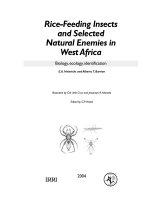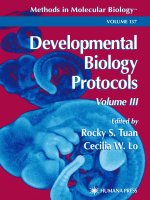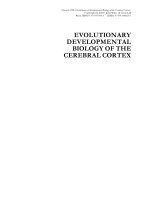key experiments in practical developmental biology - jennifer knight
Bạn đang xem bản rút gọn của tài liệu. Xem và tải ngay bản đầy đủ của tài liệu tại đây (7.71 MB, 401 trang )
TeA
M
YYeP
G
Digitally signed by
TeAM YYePG
DN: cn=TeAM
YYePG, c=US,
o=TeAM YYePG,
ou=TeAM YYePG,
email=yyepg@msn.
com
Reason: I attest to
the accuracy and
integrity of this
document
Date: 2005.10.10
19:09:06 +08'00'
P1: FCH/SPH P2: FCH/SPH QC: FCH/SPH T1: FCH
0521833159fm CB761B/Beffa March 4, 2005 9:2
ii
This page intentionally left blank
P1: FCH/SPH P2: FCH/SPH QC: FCH/SPH T1: FCH
0521833159fm CB761B/Beffa March 4, 2005 9:2
KEY EXPERIMENTS IN PRACTICAL DEVELOPMENTAL BIOLOGY
This unique resource presents twenty-seven easy-to-follow laboratory exercises
foruse in student practical classes, all of which are classic experiments in develop-
mental biology. These experiments have provided key insights into developmental
questions, and many of them are described by the leaders in the field who carried
out the original pioneering research. This book intends to bridge the gap between
state-of-the-art experimental work and the laboratory classes taken at the under-
graduate and postgraduate levels. All chapters follow the same logical format, taking
the students from materials and methods, through results and discussion, so that
they learn the underlying rationale and analysis employed in the research. Chapters
also include teaching concepts, discussion of the degree of difficulty of each exper-
iment, potential sources of failure, as well as the time required for each experiment
to be carried out in a practical class with students. The book will be an invaluable
resource for graduate students and instructors teaching practical developmental
biology courses.
Manuel Mar
´
ı-Beffa is a Lecturer in Developmental Biology at the University of
M
´
alaga.
Jennifer Knight is an Instructor in the Department of Molecular, Cellular and De-
velopmental Biology at the University of Colorado, Boulder.
i
P1: FCH/SPH P2: FCH/SPH QC: FCH/SPH T1: FCH
0521833159fm CB761B/Beffa March 4, 2005 9:2
ii
P1: FCH/SPH P2: FCH/SPH QC: FCH/SPH T1: FCH
0521833159fm CB761B/Beffa March 4, 2005 9:2
Key Experiments in Practical
Developmental Biology
Edited by
Manuel Mar
´
ı-Beffa
University of M
´
alaga
Jennifer Knight
University of Colorado
iii
Cambridge, New York, Melbourne, Madrid, Cape Town, Singapore, São Paulo
Cambridge University Press
The Edinburgh Building, Cambridge ,UK
First published in print format
- ----
- ----
© Cambridge University Press 2005
2005
Information on this title: www.cambrid
g
e.or
g
/9780521833158
This book is in copyright. Subject to statutory exception and to the provision of
relevant collective licensing agreements, no reproduction of any part may take place
without the written permission of Cambridge University Press.
- ---
- ---
Cambridge University Press has no responsibility for the persistence or accuracy of
s for external or third-party internet websites referred to in this book, and does not
guarantee that any content on such websites is, or will remain, accurate or appropriate.
Published in the United States of America by Cambridge University Press, New York
www.cambridge.org
hardback
eBook (NetLibrary)
eBook (NetLibrary)
hardback
P1: FCH/SPH P2: FCH/SPH QC: FCH/SPH T1: FCH
0521833159fm CB761B/Beffa March 4, 2005 9:2
This book is dedicated to our families
v
P1: FCH/SPH P2: FCH/SPH QC: FCH/SPH T1: FCH
0521833159fm CB761B/Beffa March 4, 2005 9:2
“. . . causes and effects are discoverable, not by reason but by experience, ”
(David Hume [1748] An Enquiry Concerning Human Understanding.
Section IV. Part I.)
vi
P1: FCH/SPH P2: FCH/SPH QC: FCH/SPH T1: FCH
0521833159fm CB761B/Beffa March 4, 2005 9:2
CONTENTS
List of contributors page xi
Preface xv
MANUEL MAR
´
I-BEFFA
Introduction 1
JENNIFER KNIGHT
SECTION I. GRAFTINGS
1. Two developmental gradients control head formation in hydra 4
H. R. BODE
2. Embryonic regulation and induction in sea urchin development 23
C. A. ETTENSOHN
3. The isthmic organizer and brain regionalization in chick embryos 37
D. ECHEVARR
´
IA and S. MART
´
INEZ
SECTION II. SPECIFIC CHEMICAL REAGENTS
4. Chemotaxis of aggregating Dictyostelium cells 50
G. GERISCH and M. ECKE
5. Inhibition of signal transduction pathways prevents head regeneration
in hydra 67
L. M. SALGADO
6. Retinoic acid during limb regeneration 77
M. MADEN
vii
P1: FCH/SPH P2: FCH/SPH QC: FCH/SPH T1: FCH
0521833159fm CB761B/Beffa March 4, 2005 9:2
viii
CONTENTS
SECTION III. BEAD IMPLANTATION
7. Experimental manipulations during limb development in avian embryos 85
Y. GA
˜
N
´
AN, J.RODR
´
IGUEZ-LE
´
ON, and D. MAC
´
IAS
8. Induction of ectopic limb outgrowth in chick with FGF-8 99
´
A. RAYA,C.RODR
´
IGUEZ ESTEBAN, and J. C. IZPIS
´
UA-BELMONTE
SECTION IV. NUCLEIC ACID INJECTIONS
9. RNAi techniques applied to freshwater planarians (Platyhelminthes)
during regeneration 106
D. BUENO, R. ROMERO, and E. SAL
´
O
10. Microinjection of Xenopus embryos 117
R. J. GARRIOCK and P. A. KRIEG
SECTION V.GENETICANALYSIS
11. Segmental specification in Drosophila melanogaster 127
L. DE NAVAS, M. SUZAN NE, D.FORONDA, and E. S
´
ANCHEZ-HERRERO
12. Genetic analysis of flower development in Arabidopsis thaliana.TheABC
model of floral organ identity determination 143
J. L. RIECHMANN
13. Genetic analysis of vulva development in C. elegans 153
S. CANEVASCINI
SECTION VI. CLONAL ANALYSIS
14.The role of the gene apterous in the development of the Drosophila wing 167
F. J. D
´
IAZ-BENJUMEA
15. Extramacrochaetae,anexample of a gene required for control of limb size
and cell differentiation during wing morphogenesis in Drosophila 178
A. BAONZA
16. Hedgehog transduction pathway is involved in pattern formation
of Drosophila melanogaster tergites 190
M. MAR
´
I-BEFFA
SECTION VII. IN SITUHYBRIDIZATION
17. Retinoic acid signalling controls anteroposterior patterning of the
zebrafish hindbrain 205
G. BEGEMANN
18.Left–right asymmetry in the mouse 217
M. BLUM, A.SCHWEICKERT,and C. KARCHER
P1: FCH/SPH P2: FCH/SPH QC: FCH/SPH T1: FCH
0521833159fm CB761B/Beffa March 4, 2005 9:2
CONTENTS
ix
SECTION VIII. TRANSGENIC ORGANISMS
19. Bicoid and Dorsal: Two transcription factor gradients that specify cell
fates in the early Drosophila embryo 231
S. ROTH
20. Significance of the temporal modulation of Hox gene expression on
segment morphology 255
J. CASTELLI-GAIR HOMBR
´
IA
21.The UAS/GAL4 system for tissue-specific analysis of EGFR gene function
in Drosophila melanogaster 269
J. B. DUFFY and N. PERRIMON
22. Neurogenesis in Drosophila:Agenetic approach 282
C. KL
¨
AMBT and H. VAESSIN
23. Role of the achaete-scute complex genes in the development of the adult
peripheral nervous system of Drosophila melanogaster 296
S. SOTILLOS and S. CAMPUZANO
SECTION IX. VERTEBRATE CLONING
24. The conservation of the genome and nuclear reprogramming in Xenopus 310
J. B. GURDON
SECTION X. CELL CULTURE
25. In vitro culture and differentiation of mouse embryonic stem cells 316
A. ROLLETSCHEK, C. WIESE, and A. M. WOBUS
SECTION XI. EVO–DEVO STUDIES
26. Microevolution between Drosophila species 330
N. SKAER and P. SIMPSON
SECTION XII. COMPUTATIONAL MODELLING
27.Theories as a tool for understanding the complex network
of molecular interactions 346
H. MEINHARDT
Appendix 1. Abbreviations 355
Appendix 2. Suppliers 363
Index 371
P1: FCH/SPH P2: FCH/SPH QC: FCH/SPH T1: FCH
0521833159fm CB761B/Beffa March 4, 2005 9:2
x
P1: FCH/SPH P2: FCH/SPH QC: FCH/SPH T1: FCH
0521833159fm CB761B/Beffa March 4, 2005 9:2
Preface
Manuel Mar
´
ı-Beffa
This handbook of laboratory exercises was first conceived at the Third Congress of the
Spanish Society of Developmental Biology held in M
´
alaga, Spain, in 2001. At the time,
Professor Antonio Garc
´
ıa-Bellido suggested including collaborators from the United
States and the rest of Europe to give the project a more international scope. The result-
ing book is a handbook intended to provide a bridge between top scientific researchers
and practical laboratories taught at both the undergraduate and postgraduate level.
Each chapter introduces a short, inexpensive, and, for the most part, straightforward
laboratory project designed to be carried out by students in a standard lab environ-
ment. The book uses some of the most popular and best studied model organisms to
examine the processes of development. Each chapter is written by specialists in the
field describing, in most instances, original pioneering experiments that profoundly
influenced the field. The book also demonstrates a historical bridge from classical em-
bryological concepts, using Aristotle and Driesch’s entelechia concept (Driesch, 1908)
(Chapters 2 and 15)ormorphogenetic gradient concept (i.e., Wolpert, 1969) (Chapters 1
and 16)tomodern cellular, genetic, and molecular analyses of development such as
homeotic genes (Chapters 11 and 20), compartmentalization (Chapter 14), or cell–cell
interactions (Chapters 2, 13, and 22). In addition, the high-impact techniques of verte-
brate cloning (Section IX) and embryonic stem cells (Section X), as well as the emerging
discipline of evolution and development (Evo–Devo, Section XI), are also considered.
Finally, although there is much still to learn in this field, Section XII is devoted to com-
putational modelling in the search for a link between genotype and phenotype. During
each laboratory exercise, it is our intent that the students imagine themselves working
with these highly respected scientists, traveling the same road pioneered by the authors
of each chapter.
Theformat of each chapter is intended to merge the format of standard scientific
papers and practical laboratory protocols – a format inspired by texts with similar intent
(Stern and Holland, 1993; Halton, Behnke, and Marshall, 2001). Each chapter also in-
cludes parts called “Alternative Exercises” and “Questions for Further Analysis” that will
permit laboratory instructors or advisors to carry out an “inquiry-based” lab format as
xv
P1: FCH/SPH P2: FCH/SPH QC: FCH/SPH T1: FCH
0521833159fm CB761B/Beffa March 4, 2005 9:2
xvi
PREFACE
supported by the National Research Council of the United States (NRC, 2000). With the
guidance provided in each chapter, students can design and carry out their own, related
experiments, potentially culminating in the writing of original papers. For most of the
laboratory exercises described, the standard laboratory safety protocols maintained in
all labs are sufficient; where necessary, more information is given about the controlled
use of hazardous substances. IN GENERAL, CAUTIONS MUST BE TAKEN. MANY OF
THE CHEMICALS USED IN THESE LABORATORY EXERCISES ARE HAZARDOUS.
TO PREVENT EXPOSURE TO THESE CHEMICALS, YOU SHOULD WEAR GLOVES
ANDSAFETY GLASSES AND WORK WITH THE CHEMICALS IN A FUME HOOD.
THIS IS PARTICULARLY IMPORTANT WHEN WORKING WITH SUBSTANCES LIKE
PARAFORMALDEHYDE, GLUTARALDEHYDE, RETINOIC ACID, DEAB, DAB XYLENE,
OR CHLORAL HYDRATE. MORE DETAILED INFORMATION ON PROPER HANDLING
OF THESE CHEMICALS CAN BE OBTAINED FROM MATERIAL SAFETY DATA SHEETS
(MSDS), WHICH ARE SUPPLIED BY THE CHEMICAL MANUFACTURERS. The animals
used in each laboratory exercise can be obtained from the curators of many interna-
tional stock centers around the world. In most countries, Home Office approvals are
required so that appropriate responsibilities must be taken by receiving departments.
REFERENCES
Aristoteles, De Anima. In Aristotle De Anima, with Translation, Introduction and Notes. ed. R. D.
Hicks (1965). Amsterdam: Adolf M. Hakkert Publ.
Driesch, H. (1908). The Science and Philosophy of the Organism. Gifford Lectures in 1908. London:
A. and C. Black.
Halton, D. W., Behnke, J. M., and Marshall, I. (eds.) (2001). Practical Exercises in Parasitology.
Cambridge: Cambridge University Press.
National Research Council (2002). Inquiry and the National Science Education Standards: A Guide
forTeaching and Learning. Center for Science, Mathematics and Engineering Education. p. 202
Washington, DC: National Academy Press.
Stern, C. D., and Holland, P. W. H. (eds.) (1993). Essential Developmental Biology. A Practical Ap-
proach.New York: Oxford University Press.
Wolpert, L. (1969). Positional information and the spatial pattern of cellular differentiation. J. Theor.
Biol., 25, 430–1.
P1: FCH/SPH P2: FCH/SPH QC: FCH/SPH T1: FCH
0521833159loc CB761B/Beffa-FMH March 2, 2005 23:39
CONTRIBUTORS
A. Baonza
MRCLaboratory of Molecular Biology
Hills Road
Cambridge CB2 2QH
UK
G. Begemann
Department of Biology
University of Konstanz
Universit
¨
atsstr. 10
D-78464 Konstanz
Germany
M. Blum
University of Hohenheim
Institute of Zoology (220)
Garbenstrasse 30
D-70593 Stuttgart
Germany
H. R. Bode
Developmental Biology Center and
Department of Developmental and
Cell Biology
University of California at Irvine
5205 McGaugh Hill
Irvine, California 92697
USA
D. Bueno
Departament de Gen
`
etica
Facultat de Biologia
Universitat de Barcelona
Av. Diagonal 645
08028 Barcelona
Spain
S. Campuzano
Centro de Biolog
´
ıa Molecular “Severo Ochoa”
Universidad Aut
´
onoma de Madrid
Cantoblanco
E-28049 Madrid
Spain
S. Canevascini
Friedrich Miescher Institute for Biomedical
Research
Maulbeerstrasse 66
4058 Basel
Switzerland
J. Castelli-Gair Hombr´ıa
Department of Zoology
University of Cambridge
Downing Street
Cambridge CB2 3EJ
UK
F. J. D´ıaz-Benjumea
Centro de Biolog
´
ıa Molecular “Severo Ochoa”
Universidad Aut
´
onoma de Madrid
Cantoblanco
E-28049 Madrid
Spain
J. B. Duffy
Department of Biology
A504/A502 Jordan Hall
Indiana University
101 E. 3rd Street
Bloomington, Indiana 47405-3700
USA
xi
P1: FCH/SPH P2: FCH/SPH QC: FCH/SPH T1: FCH
0521833159loc CB761B/Beffa-FMH March 2, 2005 23:39
xii
CONTRIBUTORS
D. Echevarr´ıa
Instituto de Neurociencias de Alicante
(UMH-CSIC)
University of Miguel Hern
´
andez
Campus de San Juan
Carretera de Valencia, Km. 87
E-03550 Alicante
Spain
M. Ecke
Max-Planck-Institut f
¨
ur Biochimie
Am Klopferspitz 18a
D-82152 Martinsried
Germany
C. A. Ettensohn
Department of Biological Sciences
Science and Technology Center for Light
Microscope Imaging and Biotechnology
Carnegie Mellon University
4400 Fifth Avenue
Pittsburgh, Pennsylvania 15213
USA
D. Foronda
Centro de Biolog
´
ıa Molecular “Severo Ochoa”
Universidad Aut
´
onoma de Madrid
Cantoblanco
E-28049 Madrid
Spain
Y. Ga ˜n´an
´
Area Anatom
´
ıa y Embriolog
´
ıa Humanas
Departamento de Ciencias Morfol
´
ogicas y
Biolog
´
ıa Celular y Animal
Facultad de Medicina
Universidad de Extremadura
E-06071 Badajoz
Spain
R. J. Garriock
Department of Cell Biology and Anatomy,
LSN 444
University of Arizona College of Medicine
P.O. Box245044
1501 N. Campbell Avenue
Tucson, Arizona 85743
USA
G. Gerisch
Max-Planck-Institut f
¨
ur Biochimie
Am Klopferspitz 18a
D-82152 Martinsried
Germany
J. B. Gurdon
Wellcome Trust/CRC Cancer UK Institute
Institute of Cancer and Developmental Biology
University of Cambridge
Tennis Court Road
Cambridge CB2 1QR
UK
J. C. Izpis ´ua-Belmonte
Gene Expression Laboratories
TheSalk Institute for Biological Studies
10010 North Torrey Pines Road
La Jolla, California 92037-1099
USA
C. Karcher
University of Hohenheim
Institute of Zoology (220)
Garbenstrasse 30
D-70593 Stuttgart
Germany
C. Kl ¨ambt
Institut f
¨
ur Neurobiologie
Universit
¨
at M
¨
unster
Badestrasse 9
D-48149 M
¨
unster
Germany
J. Knight
MCD Biology
University of Colorado
Boulder, Colorado 80309-0347
USA
P. A. Krieg
Department of Cell Biology and Anatomy,
LSN 444
University of Arizona College of Medicine
P.O. Box245044
1501 N. Campbell Avenue
Tucson, Arizona 85743
USA
P1: FCH/SPH P2: FCH/SPH QC: FCH/SPH T1: FCH
0521833159loc CB761B/Beffa-FMH March 2, 2005 23:39
CONTRIBUTORS
xiii
D. Mac´ıas
´
Area Anatom
´
ıa y Embriolog
´
ıa Humanas
Departamento de Ciencias Morfol
´
ogicas y
Biolog
´
ıa Celular y Animal
Facultad de Medicina
Universidad de Extremadura
E-06071 Badajoz
Spain
M. Maden
MRC Centre for Developmental Neurobiology
4th floor New Hunt’s House
King’s College London
Guy’s Campus
London Bridge
London SE1 1UL
UK
M. Mar´ı-Beffa
Department of Cell Biology, Genetics and
Physiology
Faculty of Science
University of M
´
alaga
E-29071 M
´
alaga
Spain
S. Mart´ınez
Instituto de Neurociencias de Alicante
(UMH-CSIC)
University of Miguel Hern
´
andez
Campus de San Juan
Carretera de Valencia, Km. 87
E-03550 Alicante
Spain
H. Meinhardt
Max-Planck-Institut f
¨
ur Entwicklungsbiologie
Spemannstr. 35
D-72076 T
¨
ubingen
Germany
L. de Navas
Centro de Biolog
´
ıa Molecular “Severo Ochoa”
Universidad Aut
´
onoma de Madrid
Cantoblanco
E-28049 Madrid
Spain
N. Perrimon
Department of Genetics and Howard Hughes
Medical Institute
Harvard Medical School HHMI
200 Longwood Ave
Boston, Massachusetts 02115-6092
USA
´
A. Raya
Gene Expression Laboratories
TheSalk Institute for Biological Studies
10010 North Torrey Pines Road
La Jolla, California 92037-1099
USA
J. L. Riechmann
Gene Expression Center
Biology
California Institute of Technology
102B Kerckhoff M/C 156-29
Pasadena, California 91125
USA
C. Rodr´ıguez Esteban
Gene Expression Laboratories
TheSalk Institute for Biological Studies
10010 North Torrey Pines Road
La Jolla, California 92037-1099
USA
J. Rodr´ıguez-Le ´on
Instituto Gulbenkian de Ci
ˆ
encia
Rua da Quinta Grande n
o
6, Apt. 14
2780-901 Oeiras
Portugal
A. Rolletschek
In Vitro Differentiation Group
Dept. of Cytogenetics
Institute of Plant Genetics and Crop Plant
Research (IPK)
Corrensstr. 3
D-06466 Gatersleben
Germany
R. Romero
Departament de Gen
`
etica
Facultat de Biologia
Universitat de Barcelona
Av. Diagonal 645
E-08028 Barcelona
Spain
P1: FCH/SPH P2: FCH/SPH QC: FCH/SPH T1: FCH
0521833159loc CB761B/Beffa-FMH March 2, 2005 23:39
xiv
CONTRIBUTORS
S. Roth
Institut f
¨
ur Entwicklungsbiologie
Universit
¨
at zu K
¨
oln
Gyrhofstr. 17
D-50923 K
¨
oln
Germany
L. M. Salgado
CINVESTAV-IPN
Dpto. Biochemistry
Apartado Postal 14-740
07000 M
´
exico, D.F.
M
´
exico
E. Sal ´o
Departament de Gen
`
etica
Facultat de Biologia
Universitat de Barcelona
Av. Diagonal 645
E-08028 Barcelona
Spain
E. S ´anchez-Herrero
Centro de Biolog
´
ıa Molecular “Severo Ochoa”
Universidad Aut
´
onoma de Madrid
Cantoblanco
E-28049 Madrid
Spain
A. Schweickert
University of Hohenheim
Institute of Zoology (220)
Garbenstrasse 30
D-70593 Stuttgart
Germany
P. Simpson
Department of Zoology
University of Cambridge
Downing Street
Cambridge CB2 3EJ
UK
N. Skaer
SkyLab, Department of Zoology
University of Cambridge
Downing Street
Cambridge CB2 3EJ
UK
S. Sotillos
Centro de Biolog
´
ıa Molecular “Severo Ochoa”
Universidad Aut
´
onoma de Madrid
Cantoblanco
E-28049 Madrid
Spain
M. Suzanne
Centro de Biolog
´
ıa Molecular “Severo Ochoa”
Universidad Aut
´
onoma de Madrid
Cantoblanco
E-28049 Madrid
Spain
H. Vaessin
Neurobiotechnology Center
Dept. of Molecular Genetics
Comprehensive Cancer Center
The Ohio State University
176 Rightmire Hall
1060 Carmack Road
Columbus, Ohio 43210
USA
C. Wiese
In Vitro Differentiation Group
Dept. of Cytogenetics
Institute of Plant Genetics and Crop Plant
Research (IPK)
Corrensstr. 3
D-06466 Gatersleben
Germany
A. M. Wobus
In Vitro Differentiation Group
Dept. of Cytogenetics
Institute of Plant Genetics and Crop Plant
Research (IPK)
Corrensstr. 3
D-06466 Gatersleben
Germany
P1: JZP/ P2:
0521833159int CB761B/Beffa February 27, 2005 1:24
Introduction
Jennifer Knight
Experiencing the process of scientific discovery is part of training to be a scientist. This
book of laboratory exercises is designed to give students an opportunity to explore and
carry out experiments that have each made significant contributions to the fields of
Experimental Embryology and Developmental Biology over the past 100 years. It is our
hope that students will experience the initial thrill of discovery as they learn how to do
each experiment, analyze each outcome, and grasp the significance of each conclusion.
However, science is not solely about the end discovery but also about the process. This
process cannot be appreciated by reading textbooks or scientific journals alone. Rather,
a budding scientist must experience firsthand the myriad pitfalls of each experiment.
Despite the way this laboratory manual is designed (with step-by-step instructions to
accomplish each experiment), students will encounter unforeseen problems in carry-
ing out the experiments. If they are not already intimately familiar with experimental
science, students will undoubtedly discover that this process demands a meticulous ap-
proach. Designing, setting up, and executing experiments cannot be accomplished in a
haphazard way. For this reason, every student must keep a laboratory notebook, a task
that many initially regard as “busy work.” In fact, keeping careful record of everything
one does in the laboratory is the only way to experience success. At the other end of
this process is presenting a finished piece of work to the scientific community. Again,
the only way to learn this aspect is to assemble data into a mock scientific “paper,” ready
for publication in a journal. If possible, verbally presenting the data to an audience is
also a valuable learning experience. Below, we give some suggestions for these two
important aspects of scientific discovery: keeping a laboratory notebook and writing a
laboratory report.
KEEPING A LABORATORY NOTEBOOK
A laboratory notebook is a day-to-day record of plans, procedures, results and interpre-
tations. When a scientist refers back to his/her notebook, the notes on procedures, pit-
falls and outcomes should help him/her to easily repeat the experiment. In the scientific
1
P1: JZP/ P2:
0521833159int CB761B/Beffa February 27, 2005 1:24
2
INTRODUCTION
community, a notebook is essential both for demonstrating integrity and for helping to
keep track of each step of an experiment. In a student laboratory setting, a notebook
can be just as useful, provided the student takes the time to make it so. A notebook
must be bound, and the first two pages should be reserved for a Table of Contents that
can be filled out as experiments are completed. When students begin an experiment,
they should write down their thoughts on the experiments, questions they may have,
and finally, their objective and hypothesis. Next, as students perform an experiment, the
actual steps should be recorded, although often this can be done in an outline format
rather than in great detail, since the procedures have already been described in the lab
manual. It is most important that students make note of problems encountered during
the experiment, or of deviations taken from the laboratory manual. These notes will
help with trouble shooting if part of the experiment does not succeed. Next, students
should record all of their observations and all of their data, both raw and calculated
(graphs, tables, etc.). Finally, when the experiment is complete, the students should
summarize their results, conclusions, and interpretations in the notebook, before mov-
ing on to the next experiment. It is essential that students realize that a laboratory
notebook is a work in progress. It is only useful if it is used during the experiment to
record the process.
WRITING A LABORATORY REPORT
A laboratory report should follow the standard format for a scientific paper, described
below.
➤
Abstract: a 4–6 sentence summary of the entire paper, including a brief statement of
the hypothesis, the methods used, the outcome, and the relevance of the experiment.
➤
Introduction: a well-researched description of the topic addressed by the experiment.
The introduction gives the reader the context of the experiment. This section should
also restate the hypothesis and describe the predictions and goals of the experiment.
➤
Materials and Methods: a detailed section in which reagents and protocols are clearly
described. Often, in a classroom setting, since these details are provided to students
in the lab manual, instructors suggest a summary of the materials and methods
used. It is still important to write in complete sentences and to accurately state how
the experiment was carried out.
➤
Results: a description of the outcome of the experiments. This section of the paper
includes only a description of the data and their presentation – figures, tables, and
graphs – but does not discuss the interpretation of the findings.
➤
Discussion: an interpretation of the experimental data and how it compares to pub-
lished information about this topic. In this section, students should discuss what
their results mean, the implications or significance of these results, and how they
might expand or clarify the results. Ultimately, it is important that students put their
experiment into the context of other work on this topic.
➤
References: a detailed citation of each journal article used in writing the paper. There
are many different possible formats for references. Students may choose a specific
P1: JZP/ P2:
0521833159int CB761B/Beffa February 27, 2005 1:24
INTRODUCTION
3
format by consulting a journal and using that standard format for each article ref-
erenced (instructions for authors, often found at the beginning of journals, usually
include instructions for referencing other journal articles).
By following the suggestions above, we hope that as instructors and students alike
perform the experiments presented in this book, you will find yourselves engaged in
and enticed by this exploration of Developmental Biology.
P1: JZP/ P2:
0521833159c01 CB761B/Beffa March 4, 2005 13:33
SECTION I. GRAFTINGS
1 Two developmental gradients control head formation in hydra
H. R. Bode
OBJECTIVE OF THE EXPERIMENT Two developmental gradients are involved in the
axial patterning of the head and the body column of a hydra. One is a morphogenetic
gradient of head activation [= head formation capacity], and the other is a gradient of
head inhibition. The objective of the experiment is to demonstrate the presence of these
two gradients in the body column of adult hydra using transplantation experiments.
DEGREE OF DIFFICULTY The experiments involve the isolation of a piece of the body
column and transplantation to the body column of a second animal. Although this
appears difficult at first sight, with a little practice, almost all students learn to carry
out these grafts at the rate of 6–10 successful grafts/hour.
INTRODUCTION
In animals, the developmental processes associated with axial patterning occur during
early stages of embryogenesis. One example involves the processes governing head
formation at the anterior end and tail formation at the posterior end of the anterior–
posterior axis. In hydra, a primitive metazoan, this type of axial patterning occurs not
only during embryogenesis, but also in the adult. This is due to the tissue dynamics of
an adult hydra.
As shown in Figure 1.1a,ahydra has the shape of a cylindrical shell. Along the
single axis are the head, body column and foot. The head at the apical end consists
of a mouth region, the hypostome, and beneath that the tentacle zone, from which
tentacles emerge. The protrusions on the lower part of the body column are early [left]
and advanced [right] stage buds, hydra’s mode of asexual reproduction. The wall of the
shell is composed of two epithelial layers, the ectoderm and endoderm, which extend
throughout the animal. Among the epithelial cells (not shown in Figure 1.1a) are smaller
cells such as neurons, secretory cells and nematocytes, the stinging cells of cnidaria.
The tissue dynamics is the following. The epithelial cells of both layers are continu-
ously in the mitotic cycle (e.g. Bode, 1996). Yet, despite the ever-increasing number of
4
P1: JZP/ P2:
0521833159c01 CB761B/Beffa March 4, 2005 13:33
INTRODUCTION
5
Tentacle
Hypostome
Bud
Peduncle
Basal disk
endoderm
ectoderm
Head
Body
Column
Foot
HI
HA
HO
a
b
Figure 1.1. (a) Cross section of an adult hydra showing the three regions and the two tissue layers as well
as two stages of bud formation. (b) Diagram of the developmental elements that control head formation.
HO = head organizer; HA = head activation gradient; HI = head inhibition gradient. (a) is adapted from
Amer. Zool., 41, 621–8 (2001).
epithelial cells, the animal remains constant in size. This occurs because the tissue of
the upper body column is apically displaced onto the tentacles and eventually sloughed
at the tentacle tips (Bode, 1996). Tissue of the lower body column is displaced down
the body column and sloughed at the foot (Figure 1.1a). Tissue from the middle of the
column is primarily displaced into developing buds, which eventually detach from the
adult. Thus, the animal is in a steady state of production and loss of tissue.
As tissue is displaced apically, it is converted into head tissue, whereas tissue dis-
placed basally becomes foot tissue. What are the axial patterning processes that control
P1: JZP/ P2:
0521833159c01 CB761B/Beffa March 4, 2005 13:33
6
TWO DEVELOPMENTAL GRADIENTS CONTROL HEAD FORMATION IN HYDRA
the changes in the fate of these moving epithelial cells? A body of transplantation and
regeneration experiments have provided insight into these processes (Browne, 1909;
Wolpert, 1971; MacWilliams, 1983a, b; Bode and Bode, 1984). Bisection of the body
column leads to the regeneration of a head at the apical end of the lower half. This
indicates that body column tissue has the capacity to form a head. Transplantation ex-
periments have shown that a head organizer region is located in the hypostome (Figure
1.1b) (Broun and Bode, 2002). This organizer transmits a signal, or morphogen, to the
body column which sets up a gradient of head formation capacity, commonly referred
to as the Head Activation Gradient (Figure 1.1b) (MacWilliams, 1983a). With this ca-
pacity, what prevents regions of body column tissue from forming heads? The head
organizer also produces and transmits an inhibitor of head formation, which is also
graded down the body column (Figure 1.1b), thereby preventing body column tissue
from forming heads (Wolpert, 1971: MacWilliams, 1983b). These two gradients control
the fate of the body column tissue as it is displaced apically. When the tissue reaches
a point where [HA] > [HI], the body column tissue is converted into head tissue. This
mechanism maintains the axial patterning at the upper end in the context of the tissue
dynamics of the animal. These gradients and their behavior have been incorporated
into a model that provides a useful overall view of axial patterning in hydra (Meinhardt,
1993; see Chapter 27).
MATERIALS AND METHODS
In this section the equipment and materials required for carrying out transplantation
experiments are described using a procedure developed by Rubin and Bode (1982).
The culture of hydra and the source of specific pieces of equipment or materials are
presented in the Appendix.
EQUIPMENT AND MATERIALS
Per student
Dissecting microscope with 10 × oculars and, optimally, variable magnification of
1–4 ×.
Pasteur pipette with rubber bulb (Fisher Scientific).
Two pairs of fine-tipped forceps (Fine Science Tools) to handle pieces of fish line
and “sleeves.”
Scalpel (Fine Science Tools). An ordinary razor blade will work equally well.
Medium-sized [60-mm diameter] plastic or glass petri dishes (Fisher Scientific).
Perpractical group. If available, an 18
❜
C incubator with a light that can be set with a
timer so that it is on a cycle for 12 h on and 12 h off. If an incubator is not available,
experimental samples can be left in the lab if the temperature is in the 15–25
❜
C range.
Biological material. One-day–starved adult hydra (see Appendix) without buds. Two
adult hydra are needed for each graft: one is the donor, and the other is the host.
Determine how many grafts will be made and obtain twice that number of adult animals.









